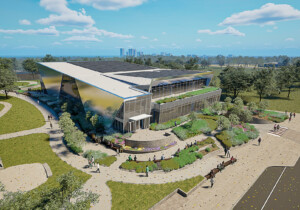The Available City
Chicago Architecture Biennial
Chicago
Open through December 18
There wasn’t much to the pavilion: a boxy open framework of green-painted lumber infilled with gauzy white curtains that caught the sunlight and flapped in the breeze. According to the press flier, The Open Workshop, a practice run by California College of the Arts professor Neeraj Bhatia, built it to serve as a meeting space for the community. The curtains, it says, can be moved to “accommodate different styles of gathering, signifying the evolving practices and values of commoning.” Bhatia calls it The Center Won’t Hold.
A big name for such a modest structure, but that’s not uncommon for temporary installations at architecture biennials, which, though often thrown together on a shoestring budget, grapple with larger themes. “The center won’t hold” is a slight misquote of a line from The Second Coming, a poem by W. B. Yeats. It is perhaps the most cribbed poem in the English language, its lines appropriated for everything from Heavy Metal lyrics to conservative talk radio screeds. “The center cannot hold,” the actual line, has been brandished recently as a shorthand for America’s cultural and societal polarization. And the poem itself, written in the aftermath of World War I, does read like a doomy prophesy of the apocalyptic politics that have characterized the last five years.
In that respect, and in a way, this modest pavilion, which sits on an asphalt lot outside the decommissioned Overton Elementary School in Chicago’s Bronzeville neighborhood, was a fitting first encounter for the fourth edition of the Chicago Architecture Biennial (CAB). This is due not only to the fact that The Center Won’t Hold references our current political trauma, but also that it offers a path toward a more harmonious future, rendering it in a simple but effective object—this one harnessing the everyday magic of sunbeam, sheet, and wind—that is delightful to experience, fulfills its brief, and endures in the mind.
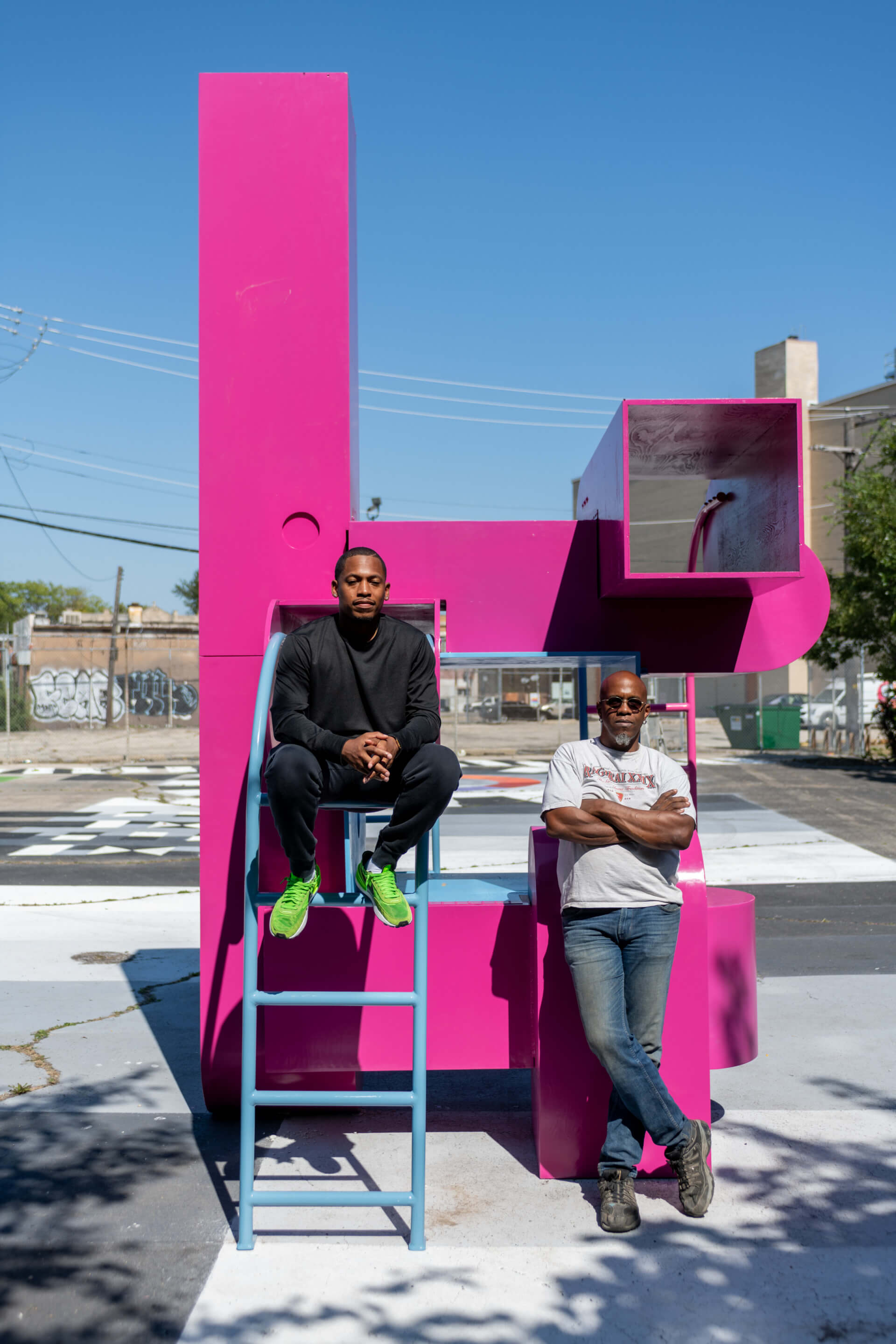
and MAS Context (Nathan Keay)
This year’s show, The Available City, is a continuation of a project that artistic director David Brown, a professor in the School of Architecture at the University of Illinois Chicago, has been working on for years. The aim is to create a collaborative, community-led framework for the development of vacant city-owned lots, of which there are more than 10,000, concentrated in Black and Brown neighborhoods on Chicago’s South and West Sides. The project was first unveiled as part of Team Chicago: City Works at the 2012 Venice Architecture Biennale, in which Brown mapped the vacant lots, coming up with an area of land roughly equal to the Chicago Loop. It appeared again at the 2015 CAB, where Brown put forth guidelines for architects and designers to work in tandem with community members to develop projects for these spaces that are, unlike so many measures that pass through the city’s planning department, sensitive to local needs. In that showing, some high-profile architects, including currently bankrupt JAHN and now-dissolved Tigerman McCurry, turned out designs that were displayed downtown at the Chicago Cultural Center.
Now in the pilot’s seat of North America’s largest architecture festival, Brown has had the opportunity to expand his decade-long research project through explorations in the field. He invited 80 contributors from more than 18 countries (though many are local, as well as Black or Brown) to team with community groups in Bronzeville, Englewood, Woodlawn, Pilsen, and North Lawndale. There are also exhibitions at the Graham Foundation and the Bronzeville Artist Lofts, plus a series of essays that will be published on the CAB website, all of which open the Biennial to perspectives from elsewhere in the U.S. and around the world. The meat of the show, however, focuses on Chicago itself and comprises installations on actual sites, all of which are outdoors in consideration of COVID.
The 2019 CAB, …And Other Such Stories, inundated visitors with histories of violence and documentation of environmental collapse, everything from squatters’ struggles in South America and garbage crises in India to gun violence in Chicago and global warming. The Beaux-Arts edifice of the Cultural Center itself, where most of the exhibitions were housed, was decorated with land acknowledgments that notified anyone who cared to look that the building stands on ground ceded from Indigenous occupants.
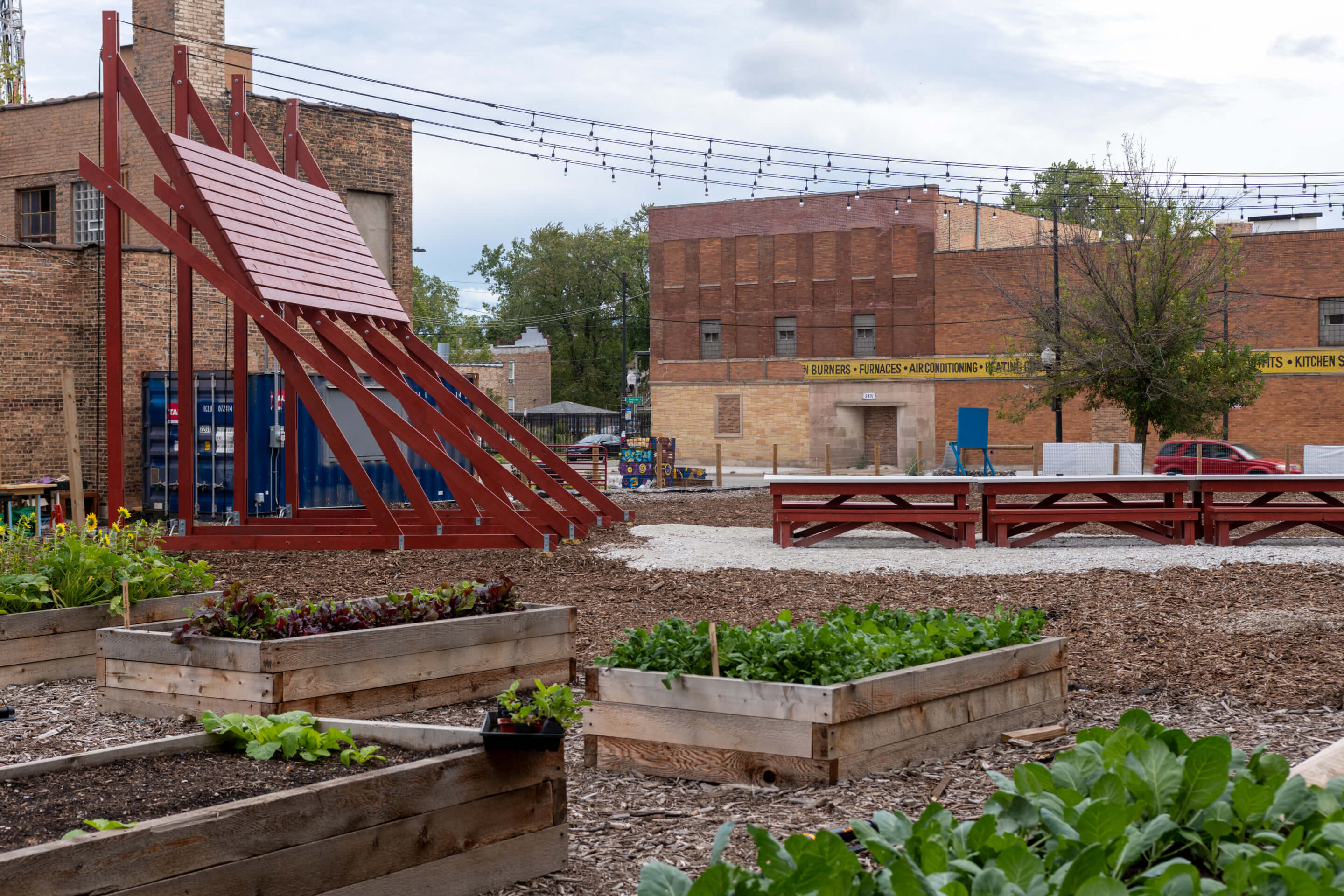
The Available City picks up where the previous edition left off, taking communities’ histories and collective aspirations as a starting point from which to explore possible solutions in situ. The word available itself, which could be taken from a realtor’s listing, puts the most positive possible spin on what much of this vacant land might be called. Anyone familiar with these neighborhoods (excepting already gentrified Pilsen), which archival photos from the not-too-distant past show as thriving urban districts, or even anyone visiting for the first time, could see in the broken-down streetscapes, the shuttered storefronts, the sheer quantity of empty lots, an index of disinvestment and neglect, and a record of the most iniquitous currents of American society.
It must be said that some visitors might feel trepidation about visiting these areas. After all, Chicago’s soaring murder rate has been endlessly publicized. For this reason, meeting the people who live in these communities, as anyone who visits during CAB’s active programming will have the opportunity to do, and experiencing their warmth, humor, pride in their place, and the ownership they evince for the results of the collaborative design projects, is essential and might be The Available City’s best aspect. With the pandemic severely limiting international visitors, this edition of CAB is more for locals, and that’s OK because it provides the potential for Chicagoans to dissolve the fear that can come from not knowing one’s neighbors and, hopefully, begin to form the bonds that will be necessary to build a more equitable future.
The projects themselves vary considerably, but most provide places to gather for events, socializing, and play. Some are ephemeral, while others are meant to serve their communities well after CAB ends its run on December 18. A clear standout is The Garden Table, Dutch practice Studio Ossidiana’s work with the El Paseo Community Garden in Pilsen, which caps a brownfield site with a sturdy assembly of modular cast concrete blocks that provide surfaces for eating, game play, plantings, wildlife habitat, sitting, lying, climbing, or just looking at. The blocks’ simple shapes—circles, squares, arches, triangles—rendered in a dusty pink with rounded edges, make for an approachable and reassuring presence in what is already a well-established community space alive with vegetables, flowers, and beehives. Another favorite in the urban furniture category is Block Party, by Studio Barnes (Miami, though founder Germane Barnes is originally from Chicago’s West Side), Shawhin Roudbari (Boulder, Colorado), and MAS Context (Chicago) in collaboration with the Westside Association for Community Action, Open Architecture Chicago, and Freedom House Studios. (The long list of contributors for such a small-scale but impactful project signals The Available City’s approach of channeling multiple voices toward pointed goals.) Located at Bell Park in North Lawndale, it is a bright pink and blue play structure inspired by the Bouncy Castles that are a ubiquitous feature of Chicago block parties. While it is not yet permitted to stand past the closing of the festival, it could and could be multiplied and deployed in other parts of the “available” city.
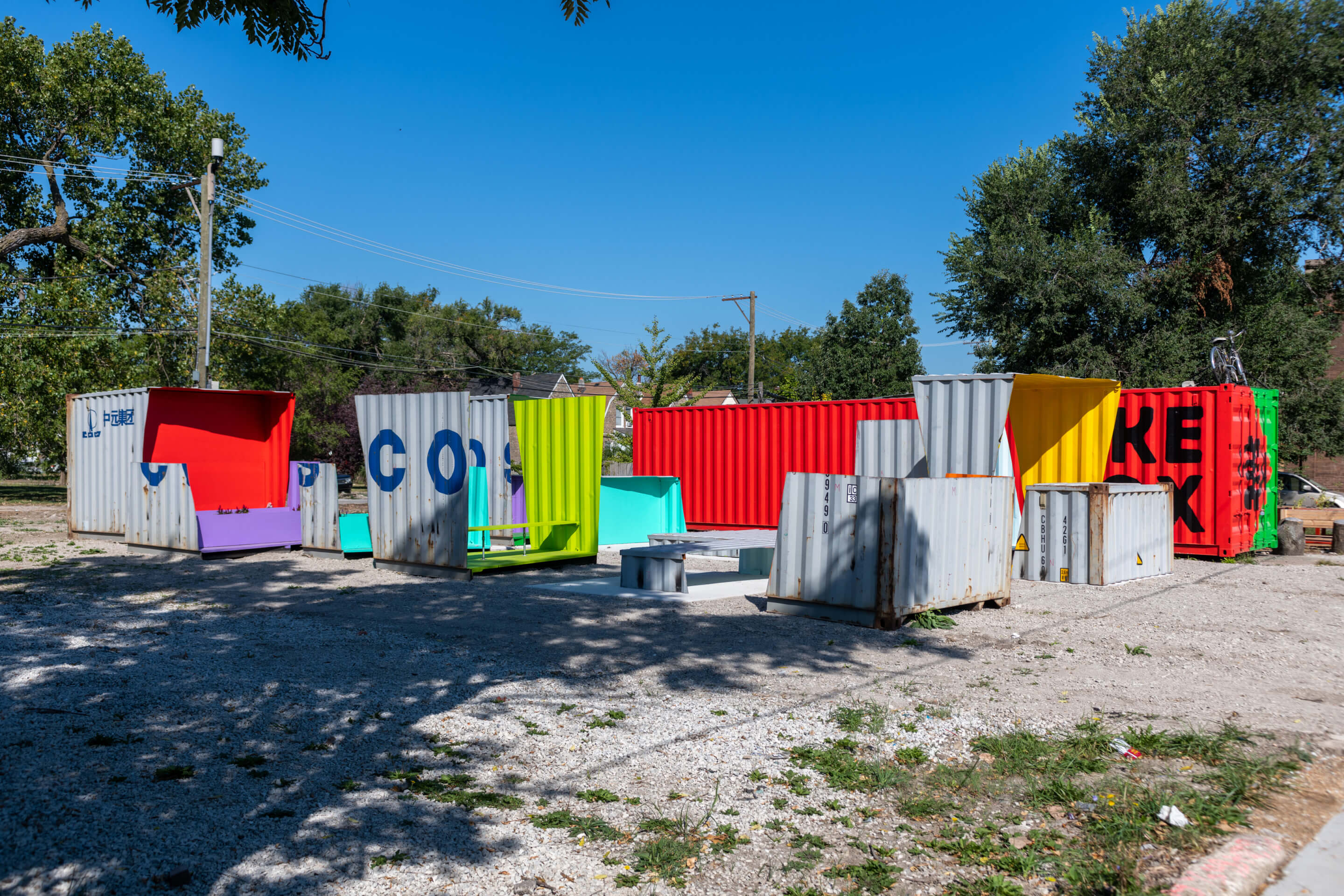
Others are more rhetorical, though no less compelling in urban terms. The Central Park Theater Restoration Committee’s collaboration with the Swiss architect Manuel Herz focuses on an endangered architectural monument, The Central Park Theater in North Lawndale, arguably America’s first movie palace, which is now a church and badly in need of repair. The project is a mural on the west side of the building, which faces an empty lot. It re-creates the floorplans and domestic spaces of the buildings that stood there until the 1960s, prompting viewers to imagine a time (could be the future) in which this place is an important cultural hub. Another intervention in North Lawndale that speaks is Grids + Griots, by Charlotte, North Carolina–based Seikou Cooke Studio and neighborhood organization Young Men’s Employment Network (YMEN). Like a DJ, the installation plays off a bike shop YMEN operates out of a shipping container, remixing it for a variety of different uses. A local metalworker cut a 40-foot shipping container (not the bike shop itself) into sections outlined in a drawing by Cooke and equipped them with some built-in furniture, a team from YMEN painted the sections vibrant colors of their choosing, and then together the architect and his collaborators distributed them across the site. Cooke loves working with metaphors, and here, in addition to harnessing ideas from rap music, he references the griot, a traveling storyteller figure in many West African cultures. One could interpret the chopped and remixed container sections as frozen hip-hop—or more accurately, “active” hip hop because the modules can be rearranged in any order that feels right—but the project may also be viewed as an expression of freedom, as embodied by the griot, an irrepressible, footloose bard who determines his own path.
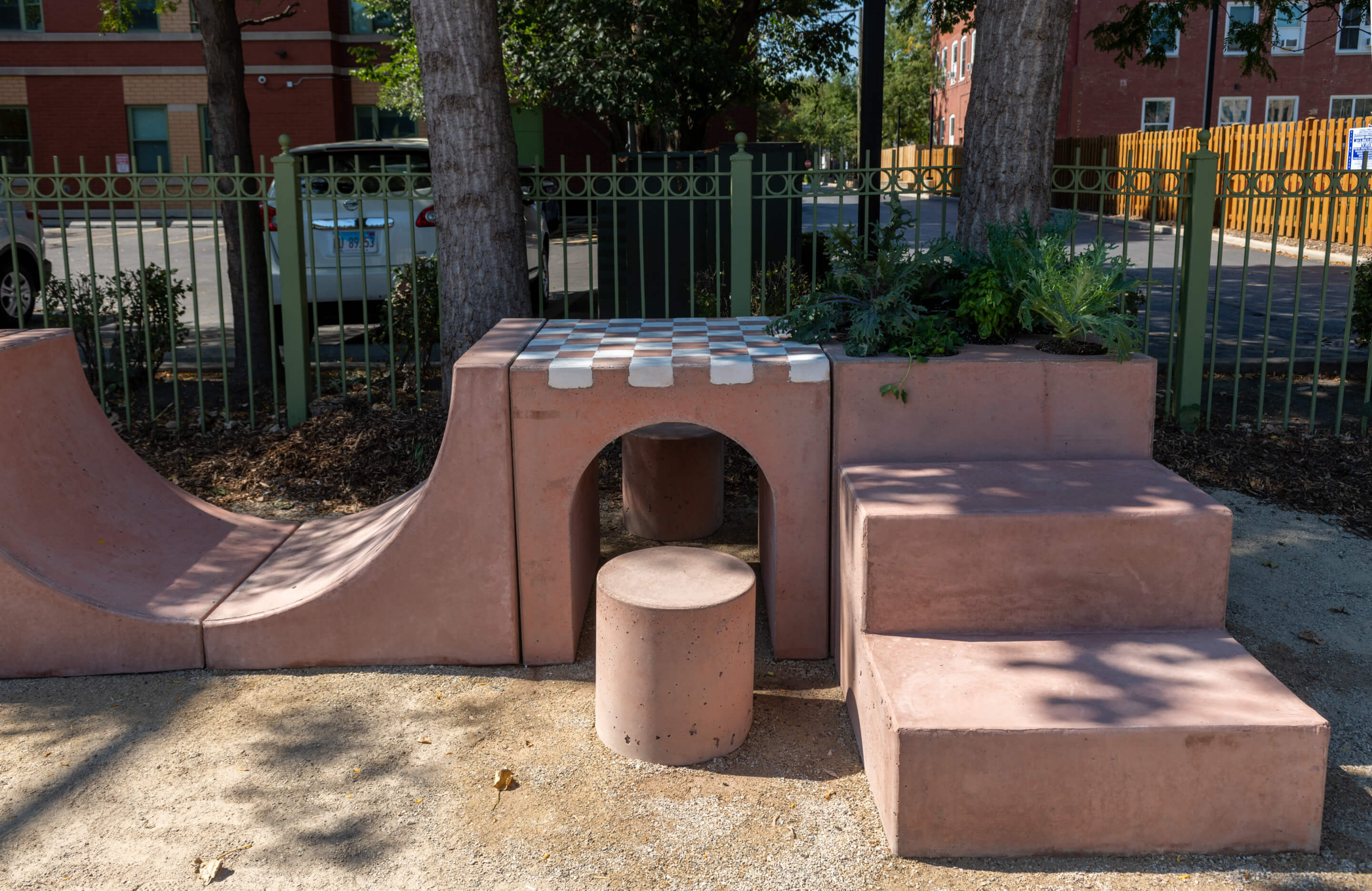
One disappointing aspect of The Available City was that Atelier Bow-Wow’s collaboration with Grow Greater Englewood was not finished for the opening and will remain under construction throughout the course of the show. Called Englewood’s Commons, it will be a community space at an entry point to the Englewood Nature Trail for Environmental Sustainability, a two-mile-long rails-to-trails project, now slated to open in 2022. While the delay could be chalked up to the pandemic slowdown, this lacuna and others gave the impression that this edition of CAB didn’t receive the same resources as previous iterations—just as the neighborhoods upon which it focuses have been historically under-resourced.
One participant, In c/o: Black Women, withdrew from the festival and, on opening day, issued a statement denouncing the Biennial as a parachute operation, decrying the lack of funding and support it gives participants, and accusing it of being yet another elitist organization exploiting Black bodies. Strong words. Whether or not the group’s claims are valid, the allegation is a reminder that fractures and hurt feelings haunt even presumably aligned groups. The center, it seems, won’t hold, as Bhatia perhaps unwittingly indicated with his pavilion, and maybe ultimately it simply cannot, as Yeats proclaimed, even if we are supplied with gauzy, sun-filled pavilions in which to hash out various styles of gathering. But to my mind Brown’s prescription of reclaiming vacant lots through collaborative, community-based design is a promising, if a tad shaky, first step toward healing a historical wound the closure of which would make our world a little more harmonious.










